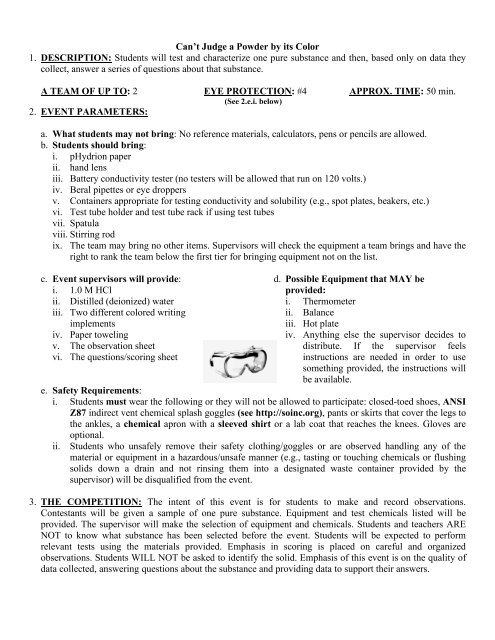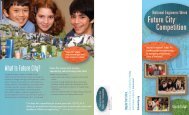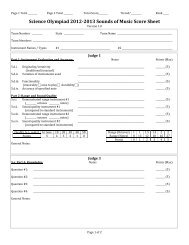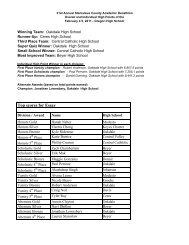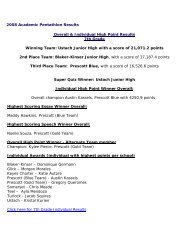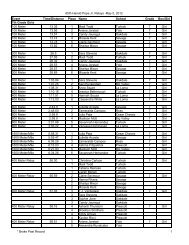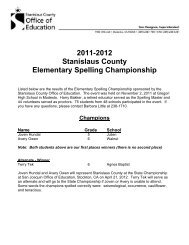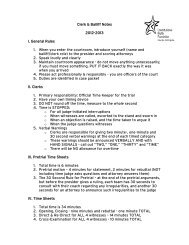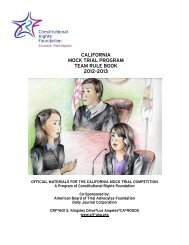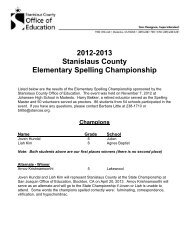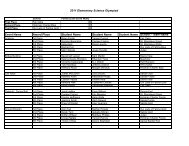Can't Judge a Powder by its Color 1. DESCRIPTION: Students will ...
Can't Judge a Powder by its Color 1. DESCRIPTION: Students will ...
Can't Judge a Powder by its Color 1. DESCRIPTION: Students will ...
You also want an ePaper? Increase the reach of your titles
YUMPU automatically turns print PDFs into web optimized ePapers that Google loves.
Can’t <strong>Judge</strong> a <strong>Powder</strong> <strong>by</strong> <strong>its</strong> <strong>Color</strong><br />
<strong>1.</strong> <strong>DESCRIPTION</strong>: <strong>Students</strong> <strong>will</strong> test and characterize one pure substance and then, based only on data they<br />
collect, answer a series of questions about that substance.<br />
A TEAM OF UP TO: 2 EYE PROTECTION: #4 APPROX. TIME: 50 min.<br />
(See 2.e.i. below)<br />
2. EVENT PARAMETERS:<br />
a. What students may not bring: No reference materials, calculators, pens or pencils are allowed.<br />
b. <strong>Students</strong> should bring:<br />
i. pHydrion paper<br />
ii. hand lens<br />
iii. Battery conductivity tester (no testers <strong>will</strong> be allowed that run on 120 volts.)<br />
iv. Beral pipettes or eye droppers<br />
v. Containers appropriate for testing conductivity and solubility (e.g., spot plates, beakers, etc.)<br />
vi. Test tube holder and test tube rack if using test tubes<br />
vii. Spatula<br />
viii. Stirring rod<br />
ix. The team may bring no other items. Supervisors <strong>will</strong> check the equipment a team brings and have the<br />
right to rank the team below the first tier for bringing equipment not on the list.<br />
c. Event supervisors <strong>will</strong> provide:<br />
i. <strong>1.</strong>0 M HCl<br />
ii. Distilled (deionized) water<br />
iii. Two different colored writing<br />
implements<br />
iv. Paper toweling<br />
v. The observation sheet<br />
vi. The questions/scoring sheet<br />
d. Possible Equipment that MAY be<br />
provided:<br />
i. Thermometer<br />
ii. Balance<br />
iii. Hot plate<br />
iv. Anything else the supervisor decides to<br />
distribute. If the supervisor feels<br />
instructions are needed in order to use<br />
something provided, the instructions <strong>will</strong><br />
be available.<br />
e. Safety Requirements:<br />
i. <strong>Students</strong> must wear the following or they <strong>will</strong> not be allowed to participate: closed-toed shoes, ANSI<br />
Z87 indirect vent chemical splash goggles (see http://soinc.org), pants or skirts that cover the legs to<br />
the ankles, a chemical apron with a sleeved shirt or a lab coat that reaches the knees. Gloves are<br />
optional.<br />
ii. <strong>Students</strong> who unsafely remove their safety clothing/goggles or are observed handling any of the<br />
material or equipment in a hazardous/unsafe manner (e.g., tasting or touching chemicals or flushing<br />
solids down a drain and not rinsing them into a designated waste container provided <strong>by</strong> the<br />
supervisor) <strong>will</strong> be disqualified from the event.<br />
3. THE COMPETITION: The intent of this event is for students to make and record observations.<br />
Contestants <strong>will</strong> be given a sample of one pure substance. Equipment and test chemicals listed <strong>will</strong> be<br />
provided. The supervisor <strong>will</strong> make the selection of equipment and chemicals. <strong>Students</strong> and teachers ARE<br />
NOT to know what substance has been selected before the event. <strong>Students</strong> <strong>will</strong> be expected to perform<br />
relevant tests using the materials provided. Emphasis in scoring is placed on careful and organized<br />
observations. <strong>Students</strong> WILL NOT be asked to identify the solid. Emphasis of this event is on the quality of<br />
data collected, answering questions about the substance and providing data to support their answers.
a. Teams <strong>will</strong> use various tests to characterize the substance. These tests are to be determined <strong>by</strong> the<br />
students, not the supervisor. It is recommended that students be given 25-35 minutes to do these tests.<br />
Data is to be recorded on a data sheet with the 1 st colored writing implement provided <strong>by</strong> the event<br />
supervisor. It should be neat and organized.<br />
b. During testing and observation of their substance, students must record their data and number it<br />
sequentially as it is collected. Any mistakes or changes should be crossed out (with one line).<br />
c. A clean up time of ≅ 10 minutes <strong>will</strong> follow. The supervisor <strong>will</strong> collect all samples and announce the<br />
appropriate clean up procedures. A scoring deduction may be incurred for improper clean up procedures.<br />
The 1 st writing implement <strong>will</strong> be collected before the questions are given to the team.<br />
d. <strong>Students</strong> <strong>will</strong> be given a 2 nd different colored writing implement and a list of questions about the<br />
characteristics of their substance. The ability to answer these questions <strong>will</strong> depend on the quality and<br />
thoroughness of their investigations. Questions <strong>will</strong> have answers that derive from student observations. If<br />
the team has sufficient data and/or observations to support the answer to a question, they are to simply<br />
place the data number(s) recorded in 3.a. beside the question. Place a number for all data that supports<br />
your answer to the question. (15 minutes) Questions <strong>will</strong> not be asked about melting point.<br />
e. Examples of Possible Substances: baking soda (NaHCO 3 ), borax, Epsom salts, sugar, alum, chalk, noniodized<br />
table salt (NaCl), sodium acetate (NaC 2 H 3 O 2 ), starch, talc, calcium carbonate, ammonium<br />
chloride, boric acid, copper (II) chloride, copper (II) sulfate, etc. Note: colored, as well as white salts are<br />
permissible.<br />
4. SAMPLE QUESTIONS:<br />
a. Is the substance soluble in water<br />
b. If soluble in water, is the solution capable of conducting a current<br />
c. Does the substance react with an acid to produce a gas<br />
d. If soluble in water, what is the approximate pH of the solution<br />
e. If soluble in water, does the substance dissolve endothermically or exothermically<br />
f. Using a hand lens, what is the shape of the individual particles or are they too small to see<br />
5. SCORING:<br />
a. Each question is worth 5 points. The number of points awarded <strong>will</strong> depend on the quality of the data<br />
and/or observations. If the team remembers an answer to a question but does NOT have the supporting<br />
data and/or observations, they may write the answer to the question with their writing implement and<br />
receive a maximum of 2 points.<br />
b. Using the most answers that received 5, then 4, then 3, etc., <strong>will</strong> break ties. Time is not a tiebreaker! For<br />
instance if a student observes that when 0.1 g of the powder is put into 5 ml of water, the powder floats on<br />
the water until it is stirred, that observation would receive 5 points to the question of what happens when<br />
the substance is placed in water. But a 4 point answer might be that the substance floats on the water. If<br />
the student writes an inference instead of an observation, such as the density of the solid is less than<br />
water, the student would receive at most 3 points.


